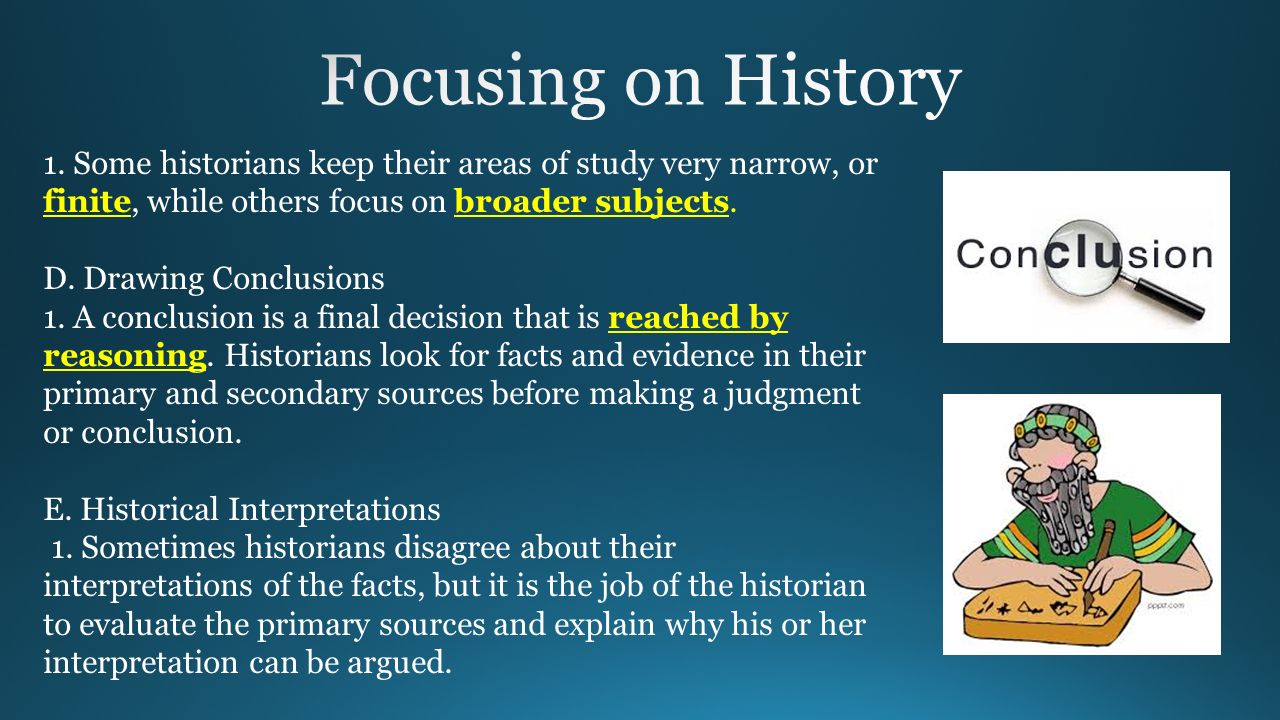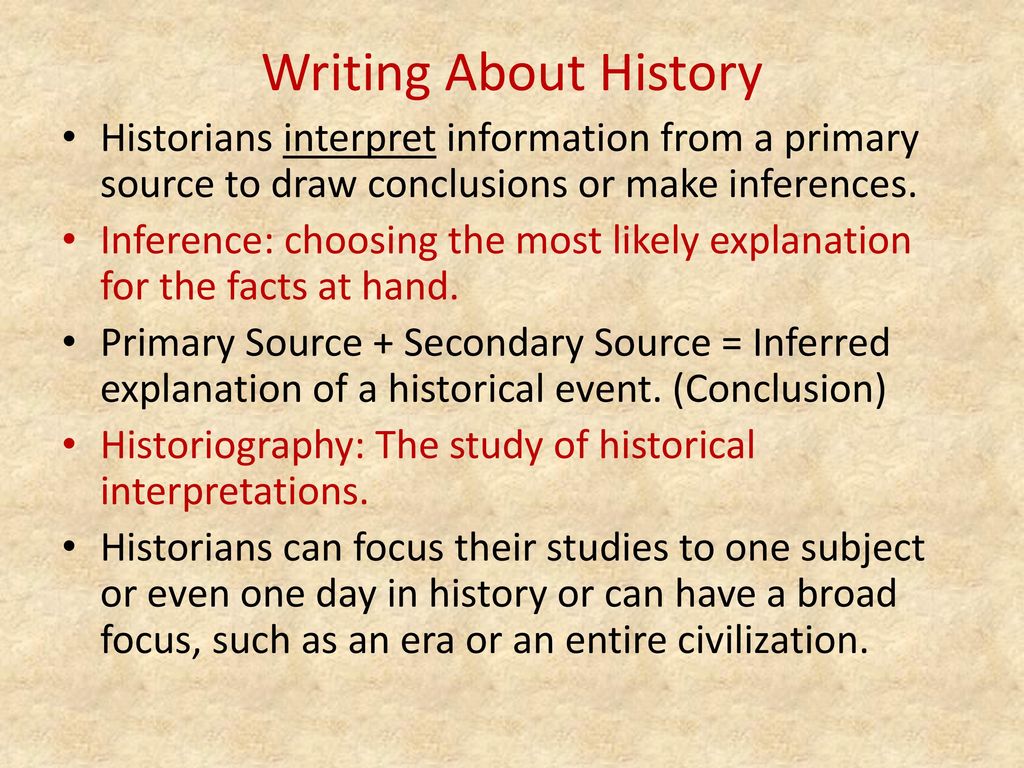Up to 24 cash back 6 and 7 Explain how historians use a variety of sources to explore the past eg H121. All of them have strengths and weaknesses that render them more useful in some situations than in others.

How Do Historians Draw Conclusions
Artifacts primary and secondary sources including narratives technology historical maps visualmathematical quantitative data radiocarbon dating DNA analysis.

. Since statistics are probabilistic in nature and findings can reflect type I or type II errors we cannot use the results of a single study to conclude with certainty that a theory is true. Drawing conclusions is an important skill for readers to learn because it encourages readers to pay attention to what they are reading use what they know from life experiences and look at the. In God we trust.
A primary source is evidence from the actual event and a secondary source is written work created after the actual event. Draw conclusions from information they have found through deciphering primary source materials. To engage in historical analysis and interpretation students must draw upon their skills ofhistorical comprehension.
Heres a brief key describing most popular methods of inference to help you whenever youre trying to. Through use of a variety of primary sources teachers address the whole spectrum of. Explanatory syntheses and argumentative syntheses.
All others must bring data. Historiography asking questions ANS-gathering evidence. How societies are similar and different.
This means that the information is never clearly stated. RH6-84Determine the meaning of words and phrases as they. There are a LOT of ways to make inferences that is for drawing conclusions based on information or evidence.
Historians have different views about the same event because of bias gender because of personal background etc. First all historians work with original sources and try to draw conclusions based on those sources. For example an historian studying Ancient Egyptian civilization would use written records archeological evidence and secondary sources.
Other tools that historians use are secondary sources. Any sort of artifact from the period in question that conveys information can qualify as a source. Yet another tool that historians use is oral history.
That famous line from statistician William Edwards. Primary and Secondary Sources. Historians are very careful when drawing conclusions and this is why they try to use different sources.
There are two types of syntheses. Why do historians sometimes draw different conclusions about the same event. This is made up of all the unwritten verbal accounts of events.
Historical sources are at their most basic level something that tells us about history. Writers often tell you more than they say directly. What to Do When People Draw Different Conclusions From the Same Data.
Argumentative syntheses seek to bring sources together to make an argument. Explain the importance of being able to analyze apply and draw conclusions from research Describe qualitative data and quantitative data and how theyre analyzed Apply the analysis findings to. Conclusions summarize whether the experiment or survey results support or contradict the original hypothesis.
The impact of past events on the present. A secondary source uses evidence from primary sources to try to figure out the past. The historical sources can be of two types ie.
A historian may rely on evidence to support different conclusions. How do historians draw conclusions. Rather theories are supported refuted or modified based on the results of research.
The historian has to evaluate the primary sources and explain why different conclusions can be argued. There are two main types of historical sources. Books and paintings that are based on primary sources and appear after an event are examples of secondary sources.
Explanatory syntheses seek to bring sources together to explain a perspective and the reasoning behind it. Include a legend g. Every historian looks at the past from their own perspective uses different sources employs their own methods and speaks in their own voice.
Non-historians read books or watch documentaries while historians do that plus go to archives in search of. All the material which has a direct bearing or can be any assistance in constructing the history of a particular period are called as historical facts or sources. Discuss the conclusions you can draw from thinking about how history is told.
It requires following and evaluating arguments and arriving at usable even if tentative conclusions based on the available evidence. If the results are statistically significant and consistent with the hypothesis and the theory that was used to. In fact there are many more than most people realize.
They give you hints or clues that help you read between the lines Using these clues to give you a deeper understanding of your reading is called inferring. Determining a sources reliability while collecting evidence. State three historical lenses that could be applied to your topic and explain how each lens can be applied.
Use the diagram to answer the question. Show each set of data in a different color or symbol f. The historians primary source is evidence from the past.
In fact there is no sharp line. The historians dream is to find fresh evidence from the past and from that evidence to create a fresh interpretation of history. Describe how one of the lenses you just identified might change how the Historical Context and Introduction you previously submitted in Project 2 were written.
The study of history is not only remembering answers. Name one way a primary source is different from a secondary source. A primary source is the evidence of an eye witness or mechanical device which was.
For example oral histories for the auditory learner and photographs and objects for the visual learners. Some of the important sources of history are as follows. They are written after a historical event by people who did not see the event.
A synthesis draws on multiple sources to reach a broader conclusion. Historians who write history emphasize the value of primary sources that is those sources actually dating from a particular time period while understanding the limitations of such sources. There are several reasons for this.
The strengths and weaknesses of different sources. Primary sources and secondary sources. Historians often reach different conclusions or answers from the same evidence.
Convert data to show all units of measurement on the same scale Now that you have analyzed your data the last step is to draw your conclusions. Drawing conclusions refers to information that is implied or inferred. Common Core State Standards.
Address Various Learning Styles. Second one does not have to physically own a copy of the document in order to read and interpret what it is saying. It may be a document a picture a sound recording a book a cinema film a television program or an object.

How Does A Historian Work Ppt Video Online Download

How Does A Historian Work Ppt Download

These Critical Thinking Skills Posters For Social Studies And Social Studies Middle School Middle School Social Studies Classroom High School History Classroom
0 Comments